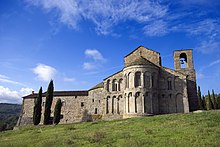Pieve di San Pietro a Romena
The Pieve di San Pietro a Romena is a small Romanesque church near the Tuscan community of Pratovecchio in Casentino . Although it is very simple, it is one of the most important rural churches in Tuscany because of some special features.
Location and name
The church is located about 1.5 kilometers south-southwest of the city center of Pratovecchio on Strada Provinciale di San Pietro a Romena , which merges here into Strada Communale di San Paolo .
She has the first part of the name in her former function as Pieve . The addition after the patronage name of Simon Petrus ( Italian : San Pietro ), "a Romena" refers to the Castello di Romena , about 600 meters to the north , a former castle of the Counts of Romena from the Guidi family .
Building history
A previous building at this point was a Lombard - Carolingian church from the 8th or 9th century. Remnants of the foundations, excavated in the last half of the 20th century, are still preserved. It can be seen in the church today and shows the apse structure of this building. The lower part of the attached campanile also dates from that time .
An inscription on a capital shows that the current construction began in 1152, it is summarized as follows: “In the famine year 1152, Pastor Albericus created this building.” Art history assumes that the church was built by a special group of craftsmen from Lombardy , who had received her training in the French Auvergne . According to matching characteristics, these builders could be responsible for at least three other church buildings in Tuscany.
Originally the church was longer. It was shortened in the west by about a third - two transverse axes - after a collapse in 1678 and an earthquake in 1729. The facade is therefore only made of coarse stone today and is negligible.
Today the church is the seat of the Fraternità di Romena community .
Interior
The type of the church is a pillar basilica , accordingly it has three naves with a raised central nave. The church does not have a transept, on the east side the central nave ends in a two-storey apse. The last axes of the side aisles are covered with barrel vaults, just like the last arcade arches in front of the apse are significantly smaller than the others. It is assumed that this construction was possibly intended to represent a kind of "simplified chapel wreath".
The church is otherwise not vaulted, the wooden roof structure is clearly visible.
Of interest are the pillars that support the arcade arches. They have a very strong entasis , their capitals are simplified according to ancient models, but richly decorated with leaves and figures. This type of column instead of the usual pillars is only found in a few churches in the Casentin and is very similar in these buildings, which supports the assumption that it was a special group of craftsmen as builders.
Another peculiarity is that both the inside and the outside, there also the east sides of the aisles, of the apse are decorated and structured by two superimposed rows of blind arcades. This is also very unusual for rural Tuscan churches and is reminiscent of Luccesian church buildings.
literature
- Heinz Schomann : Art monuments in Tuscany. Scientific Book Society, Darmstadt 1990
- Klaus Zimmermanns: Toscana - The hill country and the historic city centers. 9th edition, Du Mont Buchverlag, Cologne 1986, ISBN 3-7701-1050-1
Web links
- Website of the Fraternità di Romena , Italian
Individual evidence
- ↑ Schomann: Kunstdenkmäler in der Toskana , p. 459.
- ↑ Schomann: Kunstdenkmäler in der Toskana , p. 459.
- ^ Zimmermanns: Toscana - The hill country and the historic city centers , p. 343.
- ^ Zimmermanns: Toscana - The hill country and the historic city centers , p. 344.
- ↑ Schomann: Kunstdenkmäler in der Toskana , p. 459.
- ↑ cf. Zimmermanns: Toscana - The hill country and the historic city centers , p. 344.
- ↑ Schomann: Art Monuments in Tuscany , p. 458.
Coordinates: 43 ° 46 ′ 27.6 " N , 11 ° 42 ′ 58.9" E
